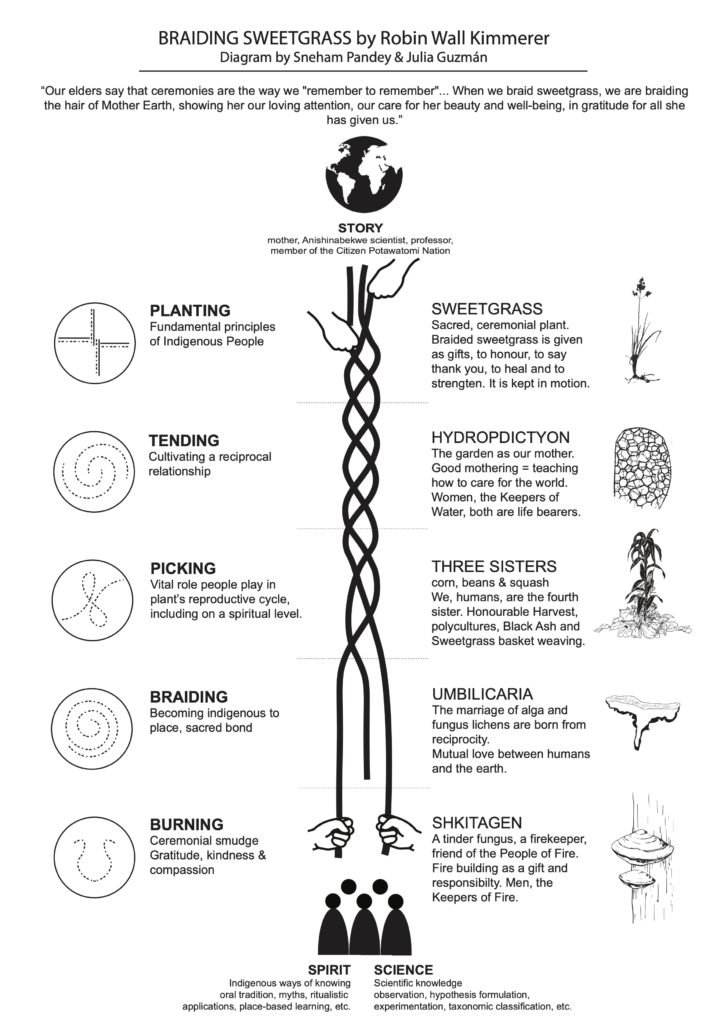Indigenous Wisdom, Scientific Knowledge, and the Teachings of Plants
Braiding Sweetgrass is a book written by Robin Wall Kimmerer, an indigenous ecologist, scientist and an enrolled member of the Citizen Potawatomi Nation. The book is a collection of essays that explore the relationship between humans and the natural world. Through her writing, Kimmerer presents a vision of a world in which humans and nature exist in a reciprocal relationship, each benefiting from the other. The book is divided into five sections that are essentially the rituals connected to sweetgrass. The book is presented as a braid of stories. Each section presents a different aspect of our relationship with the natural world, and includes stories, scientific observations, and personal anecdotes.

The diagram revolves around the idea of braiding story, spirit and science. The braid signifies the reciprocal relationship between nature and humans. The story entail Kimmerer’s childhood; Potawatomi heritage; her journey studying botany and becoming a decorated professor, and motherhood. The spirit is brought through the indigenous ways of knowing such as oral traditions, beliefs and rituals. The science is expressed through scientific knowledge, experimentation and taxonomic classification. The diagram presents an icon representing the different chapters of the books- planting, tending, picking, braiding and burning-which coordinate with the sequence of rituals related to sweetgrass. A botanical example is illustrated from each section of the book that the author has used to convey the message of the section of the book.
The chapter Planting establishes the fundamental principles of indigenous people. The example picked is sweetgrass, which is considered a sacred, ceremonial plant. Tending encourages to cultivate a reciprocal relationship and how to care about the world. Here, the author has talked about Hydropdictyon as a mother. This section focuses on good mothering and her relationship with her daughters. She mentions how she has taught her daughters to take care of the garden, a garden is a mother that will always take care of us. She shares that in her culture women are considered the Keepers of Water, both being life bearers.
Picking highlights the vital role humans play in plants reproductive cycle with the example of three sisters- corn, bean and squash, humans being the forth sister. The three sisters are an example of polycultures and understanding that everything sinks and floats together in the web of reciprocity. This chapter introduces the concept of Honorable Harvest- cultivating respect and gratitude towards the gifts of nature. In the chapter Braiding, the author gives notes on how to become indigenous to a place. Through the example of Umbilicaria, she expands on the necessity to recognize our sacred bond with nature. The Umbilicaria is a symbol of reciprocity, born out of the marriage of alga and fungus and also considered the belly button of the world.
In the last chapter Burning, the author focuses on feeling gratitude and compassion towards nature and repair our relationship towards it. An interesting anecdote shared in this chapter is of her father (being Potawatomi- People of Fire) teaching children the different kinds of fires. He explains how we all are Fire Keepers, as we carry a fire within us. Through this story, Kimmerer mentions the how fire building is a gift of her people and the responsibilities connected to it. Another example shared here is of the Chaga mushroom, Shkitagen. It is a tinder fungus, a firekeeper friend of the People of fire. It does not burn when it comes in contact of fire, instead it smolders and holds the fire.

